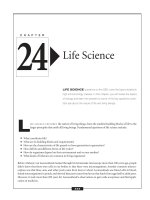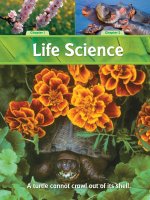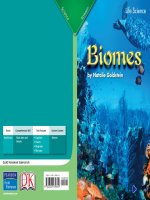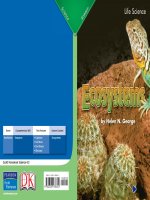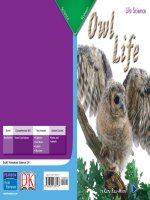3 3 earths ecosystems (life science)
Bạn đang xem bản rút gọn của tài liệu. Xem và tải ngay bản đầy đủ của tài liệu tại đây (4.51 MB, 14 trang )
Genre
Nonfiction
Comprehension Skill
Main Idea and Details •
•
•
•
Text Features
Captions
Labels
Text Boxes
Glossary
Science Content
Ecosystems
Scott Foresman Science 3.3
ISBN 0-328-13815-0
ì<(sk$m)=bdibfj< +^-Ä-U-Ä-U
Vocabulary
community
desert
ecosystem
environment
grassland
population
tundra
wetland
What did you learn?
1. What happens when one part of
an ecosystem changes?
2. Why can’t trees grow in
some grasslands?
3. Lemmings are able to live on
the tundra. Why?
by Barbara Fierman
Picture Credits
Every effort has been made to secure permission and provide appropriate credit for photographic material.
The publisher deeply regrets any omission and pledges to correct errors called to its attention in subsequent editions.
Photo locators denoted as follows: Top (T), Center (C), Bottom (B), Left (L), Right (R), Background (Bkgd).
Opener: Digital Vision; 1 Getty Images; 3 (T) Getty Images; 5 Getty Images; 7 ©Jerry Young/DK Images; 8 Tom Bean/Corbis;
11 Digital Vision; 12 Francois Gohier/Ardea; 14 Getty Images; 15 Digital Vision; 16 (BC) ©Jerry Young/DK Images;
18 (Bkgd) Getty Images; 22 (CR) Tom Bean/Corbis, (BC) Digital Vision; 23 (CR) Francois Gohier/Ardea, (BC) Getty Images.
Scott Foresman/Dorling Kindersley would also like to thank: 10 (BC) Jerry Young/DK Images.
Unless otherwise acknowledged, all photographs are the copyright © of Dorling Kindersley, a division of Pearson.
ISBN: 0-328-13815-0
Copyright © Pearson Education, Inc. All Rights Reserved. Printed in the United States of America.
This publication is protected by Copyright, and permission should be obtained from the publisher prior to any
prohibited reproduction, storage in a retrieval system, or transmission in any form by any means, electronic,
mechanical, photocopying, recording, or likewise. For information regarding permission(s), write to
Permissions Department, Scott Foresman, 1900 East Lake Avenue, Glenview, Illinois 60025.
3 4 5 6 7 8 9 10 V010 13 12 11 10 09 08 07 06 05
4.
You have read
about the importance of prairie dogs
in their habitat. Write to explain the
things that prairie dogs do to help
keep other living things alive.
5.
Main Idea and Details A tropical
forest is one kind of ecosystem. List
some details from the book about
this forest.
Places For
Living Things
Living things get what they need from
where they live. A living thing’s environment
is everything that is around it. Plants and
animals are living parts of an environment.
Some nonliving parts are sunshine, water, soil,
and weather.
Sunshine warms the air, water, and soil.
It allows plants and animals to live in those
places. Water and soil are important parts of
the environment. Water falls as rain and snow.
It goes into the soil. Some soils hold a lot
of water. Other soils hold very little. Plants
need different types of soil.
Climate is the weather a place has during
the year. In some places, the climate is cold
and dry. In other places, the climate is hot and
wet. Many places have climates with changing
seasons.
A moose’s environment
is a coniferous forest.
2
3
Parts of an Ecosystem
Prairie dogs live in
underground holes.
Special Homes
Every plant and animal has a special place
to live. This place is called its habitat. Living
things get what they need in their habitat. Plants
get light, air, water, and space to grow. Animals
get food, water, and a space to live and grow.
If one part of a habitat is taken away,
the habitat will change. If prairie dogs leave
their habitat, the animals that use the prairie
dog holes might have to move or find other
places to live.
Plants and animals live where they have water,
food, and shelter. An ecosystem contains all
the plants, animals, and nonliving things in
an environment. The different parts of an
ecosystem work together.
Prairie dogs dig holes in the soil. This gives
the soil more air. The air helps the grass grow.
This makes more grass for animals to eat.
The living parts of an ecosystem also need
each other. Burrowing owls and other animals
often use the holes dug by prairie dogs.
The cactus lives in a desert habitat.
4
5
Groups within Ecosystems
African elephants
The elephants live by a lake. They live together.
The elephants are able to get water and rest at the
lake. They take care of each other. The elephants
make up a population.
Birds come to live at the lake. They make nests
and find fish in the lake. Other animals find food
at the lake too. The elephants, birds, and other
animals each belong to their own populations.
Together they make up a community of animals.
The animals in the community need each other
and the lake in order to live.
6
Ecosystems Change
Sometimes ecosystems change. First, one part
of the ecosystem changes. Then the other parts
change too.
Long ago, many wolves lived in Yellowstone
National Park. The wolves ate elk and other
animals. People wanted to get rid of the wolves.
They killed many of them.
When the wolves were gone, there were not
enough animals to eat the elk. Yellowstone’s
elk population grew out of control. There were
too many elk and not enough food. Many of the
elk died. Finally, people devided to bring wolves
back to the park.
Gray wolf
7
Grassland
A grassland is a large, flat area of land that is
covered with grass. There are grasslands all over
the world. The grasslands of North America and
Asia usually have cold, snowy winters and hot
summers. African grasslands are much warmer.
In some grasslands the soil is too dry for
trees to grow. Trees need more water than the
grassland gets.
During the spring and summer, it rains in
the grassland. The rain soaks into the ground.
The grasses have long roots that go deep into
the ground. These roots can get water in the
drier seasons.
8
Some grasslands get more rain than
other grasslands. Tall grasses can grow in
these grasslands. Short grasses grow where
there is less rainfall. Wildflowers grow in
grasslands too.
Many animals live in a grassland
ecosystem. Rabbits, deer, and prairie dogs
eat the grasses. Foxes, snakes, and other
animals eat the smaller animals. Birds such
as owls and sparrows also live in grasslands.
American bison, or buffalo, live in
the grasslands of North America.
9
Desert
A desert is a place that gets very little rain.
Most deserts get less than five inches of rain a year.
During the day the desert can be very hot. At night
it is much cooler.
The plants and animals in the desert need each
other. All of the desert’s living things have found
ways to stay alive without needing much water.
One kind of desert plant is the cactus. Cactuses
keep water in their stems. Their roots spread out
to get water from the soil. They have special skin
that keeps water in.
Desert animals hide when it is hot. Some sleep
in the shade of plants. Others, such as some frogs
and toads, dig tunnels under the ground. Desert
animals such as snakes and coyotes often go out
at night when it is cool to hunt for birds and
other small animals.
When days are hot,
the rattlesnake hunts
at night.
10
11
Tundra
The Arctic tundra is a very cold and dry
ecosystem. It is located near the North Pole.
Winters on the tundra are long and cold.
Some snow falls, and it is very windy. The days
are short, and the nights are very long. For many
weeks the Sun does not shine at all. The ground
is frozen all the time.
Summers on the tundra are short and cool.
The days are long and sunny. In some places,
the Sun shines twenty-four hours a day. The snow
melts, but the soil under the ground stays frozen.
Many plants, such as trees, can’t grow in
the tundra. In fact, the word tundra means
“treeless land.”
Other plants, such as grasses and wildflowers,
can grow there. These plants are small and have
short roots. Many tundra plants have tiny hairs
on their stems or leaves. The hairs help protect
the plants from the wind.
In the summer, ponds form on the tundra.
Ducks, geese, and other birds make nests near
the ponds. There are many insects to eat during
the tundra summer. Most of the birds in the
tundra fly to warmer places in the winter.
Lemmings are small animals that live in the
tundra. They dig in the snow to find grass, moss,
and twigs to eat. They have thick fur that helps
keep them warm.
Most of the tundra’s
flowers and plants
are small. This helps
protect them from
the strong winds.
12
13
Coniferous Forest
Deciduous Forest
Earth has many different kinds of forests.
Each forest has its own plants and animals.
Coniferous forests grow in places with
warm summers and cold, snowy winters.
Coniferous trees have leaves that look like
needles. Both spruce and pine trees are conifers.
Coniferous trees grow close together.
This helps protect them from the cold and
wind. It is hard for plants to grow under conifers.
They don’t get enough sunlight. Moss, however,
grows beneath these trees.
Many animals, such as bears, live in coniferous
forests. Bears have thick fur to help them stay
warm. They sleep through the cold winters. Birds
eat seeds from the trees in summer. Then they fly
to warmer places in winter.
Deciduous forests grow where it rains in the
summer and snows in the winter. In the fall,
the leaves on deciduous trees change color.
They change from green to yellow, orange, or red.
Then the trees drop their leaves. In the spring,
they grow new leaves that stay green all summer.
Both oak and maple trees are deciduous.
It is easier for plants to grow in deciduous
forests. Flowers, ferns, and moss grow on the
deciduous forest floor.
Many animals live in a deciduous forest.
Insects, birds, and small animals make their
homes in the trees. Many small animals eat the
trees’ leaves, nuts, and seeds. Owls and foxes
live in deciduous forests. They find squirrels
and other small animals to eat.
14
15
Tropical Forest
Tropical forests grow in places that are mostly
warm and wet all year long. The trees that grow
there are very tall. Some tropical forest trees are
as tall as a ten-story building! The leaves on top
of the trees keep much of the sunlight out.
Many plants can’t grow under the trees because
they don’t get enough sunlight.
Some plants can grow on the branches
and trunks of the trees. These plants are called
air plants. They get water and food from the air.
Vines also grow on the trees.
Many animals live in the tropical forest.
Most live in the trees. Frogs and spiders live
under the leaves. Ants and beetles live under
the bark. Snakes wind around the trunks.
Monkeys swing from tree to tree, and colorful
birds sit on the branches.
Many, many insects live in tropical forests.
How many? So many that scientists haven’t
even named them all!
Orchids are air plants.
Their roots dangle
in the air to get food
and water.
Many tropical forest insects
are hard to see. They look
like sticks or leaves.
16
17
Freshwater
Ecosystems
Some ecosystems have fresh water. Other
ecosystems have salt water. In some places
fresh water and salt water come together.
Lakes, ponds, rivers, and streams are all
freshwater ecosystems. Lakes and ponds have
land all around them. In rivers and streams,
the water moves from one place to another.
The water in some lakes and rivers comes from
under the ground. The water in others comes
from rain or melting snow.
A wetland is land that is covered by water
most of the time. Trees, grasses, and plants
grow in a wetland. Many animals live there too.
Some wetland birds have long legs that help
them walk in the water. They have beaks for
catching fish to eat. Wetland frogs and toads
can live in the water and on the land.
18
The largest freshwater wetland is in Brazil.
Many large rivers run through Brazil. When
it rains, these rivers can overflow, flooding the
surrounding land. The flooded land becomes
a wetland habitat for many plants and animals.
Many birds stay in the wetlands of Brazil for
a short time while they are traveling to other
places. Many fish live there too. The wetlands
of Brazil are also home to capybaras. They have
webbed feet, like a duck. Their webbed feet
help them swim.
Capybaras’ eyes and ears are on top of
their heads. This helps them to see
and hear when swimming.
19
Saltwater Ecosystems
Earth’s oceans contain almost all of its salt
water. They cover most of the planet. Near the
land, the ocean is not very deep. Clams, crabs,
and some kinds of fish live there.
Far from land, the ocean water is deep. Large
fish, sharks, and whales can live in deep water.
The deepest parts of the oceans are dark and
cold. Very few plants can grow there because
there is little sunlight.
Rivers flow into oceans. The fresh water
from rivers mixes with salt water from the ocean.
When this happens, salt marshes are formed.
A salt marsh is a type of wetland. Most of
the salt marsh is covered with water. Many
grasses grow in the salt marsh. These grasses
can live in water and soil that is salty.
Some of the animals in the salt marsh
are so small that you can’t see them. Many
sea animals start their life in salt marshes
before moving out to the ocean.
Flamingos eat
the tiny insects
and plants found
in salt marshes.
20
21
The World Around You
We have now talked about many ecosystems.
Yet there are still thousands more, found all over
Earth. Ecosystems are everywhere. But they are
difficult to define and measure because they are
always changing. Climate changes. Hurricanes, and
volcanic eruptions change ecosystems. Human
activities and the interactions between plants and
animals also change ecosystems.
Ecosystems’ constant changes can be difficult
and confusing to track. Many people try to get
rid of that confusion by thinking of Earth as
one big ecosystem! However you like to think
about it, one thing is for certain: ecosystems need
to be protected, so every living plant and animal
can have a home.
Tundra
Coniferous
forest
Grassland
Tropical forest
Desert
22
Wetland
23
Vocabulary
Glossary
community
desert
community
a group of different types of
ecosystem animals living together in one
environmentplace and needing each other
grassland to live
population
desert
a place that gets very little rain
tundra
ecosystem
all of the different plants, animals,
wetland
and nonliving things in one place
that use each other
environment everything surrounding a
living thing
grassland
a large, flat area of land that is
covered with grass
population
all the living things of one kind
in one place
Picture Credits
Every effort has been made to secure permission and provide appropriate credit for photographic material.
The publisher deeply regrets any omission and pledges to correct errors called to its attention in subsequent editions.
a cold and dry area where some
part of the ground or soil is frozen
for the entire year
Scott Foresman/Dorling Kindersley would also like to thank: 10 (BC) Jerry Young/DK Images.
tundra
Photo locators denoted as follows: Top (T), Center (C), Bottom (B), Left (L), Right (R), Background (Bkgd).
Opener: Digital Vision; 1 Getty Images; 3 (T) Getty Images; 5 Getty Images; 7 ©Jerry Young/DK Images; 8 Tom Bean/Corbis;
11 Digital Vision; 12 Francois Gohier/Ardea; 14 Getty Images; 15 Digital Vision; 16 (BC) ©Jerry Young/DK Images;
18 (Bkgd) Getty Images; 22 (CR) Tom Bean/Corbis, (BC) Digital Vision; 23 (CR) Francois Gohier/Ardea, (BC) Getty Images.
a land that traps water or stays
covered in water for most of
the year
Unless otherwise acknowledged, all photographs are the copyright © of Dorling Kindersley, a division of Pearson.
wetland
ISBN: 0-328-13815-0
Copyright © Pearson Education, Inc. All Rights Reserved. Printed in the United States of America.
This publication is protected by Copyright, and permission should be obtained from the publisher prior to any
prohibited reproduction, storage in a retrieval system, or transmission in any form by any means, electronic,
mechanical, photocopying, recording, or likewise. For information regarding permission(s), write to
Permissions Department, Scott Foresman, 1900 East Lake Avenue, Glenview, Illinois 60025.
24
3 4 5 6 7 8 9 10 V010 13 12 11 10 09 08 07 06 05
What did you learn?
1. What happens when one part of
an ecosystem changes?
2. Why can’t trees grow in
some grasslands?
3. Lemmings are able to live on
the tundra. Why?
4.
You have read
about the importance of prairie dogs
in their habitat. Write to explain the
things that prairie dogs do to help
keep other living things alive.
5.
Main Idea and Details A tropical
forest is one kind of ecosystem. List
some details from the book about
this forest.
